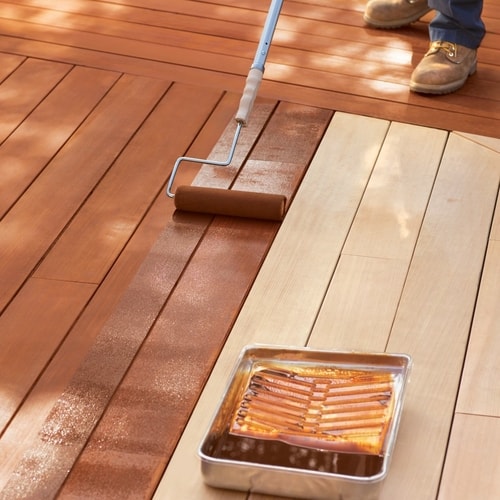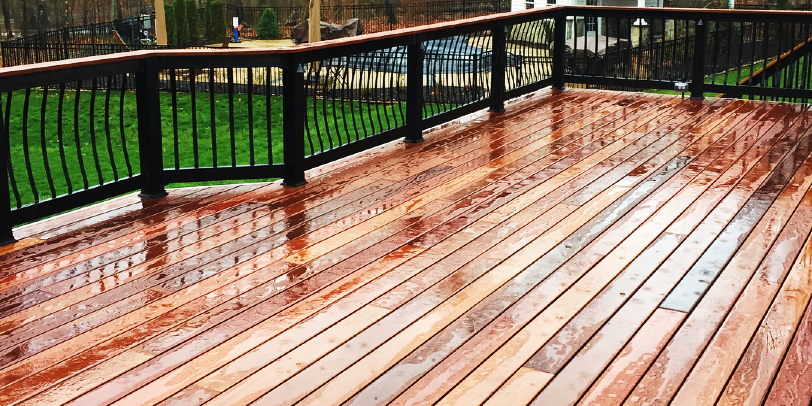Deck Staining Excellence: Nourishing Your Exterior Hideaway
Deck Staining Excellence: Nourishing Your Exterior Hideaway
Blog Article
Picking the Right Spot for Your Fence: Tips and Factors To Consider
When it pertains to boosting the appearance and keeping of your fence, picking the ideal stain is critical. With a wide range of alternatives offered, it can be overwhelming to establish which discolor will certainly finest match your requirements. This guide will certainly provide you with factors to consider and tips to aid you make an informed choice. We will discover the various kinds of fencing stains, aspects to consider before selecting a tarnish, suggestions for preparing your fencing for discoloration, and the distinctions between water-based and oil-based discolorations. Additionally, we will dive right into choosing the best tarnish shade to complement your fence and enhance your outside room. By adhering to these guidelines, you can guarantee that your fencing continues to be protected and visually pleasing for several years ahead.
Comprehending Different Kinds Of Fencing Spots

On the various other hand, water-based discolorations are made from acrylic or latex and use a more refined color to the wood. They create a safety film on the surface area of the timber, preventing wetness from permeating in and protecting versus UV damage. Water-based stains are less complicated to tidy up and have a much faster drying time compared to oil-based stains. They are also much less likely to discolor or crack over time.
Choosing between water-based and oil-based discolorations relies on numerous factors, including personal preference, the preferred appearance, and the degree of upkeep called for. Oil-based discolorations are recommended for fence high-traffic areas or those regularly subjected to severe climate condition. deck staining. Water-based stains, on the other hand, are a popular choice for fences in houses where appearance and ease of use are necessary
When choosing the right stain for their fencing,Comprehending the distinctions between oil-based and water-based spots helps property owners make a notified decision. Taking into consideration the certain demands of the fence, such as its place, exposure to sunshine, and preferred aesthetic, will certainly ensure that the picked discolor provides durable security and enhances the total charm of the fence.
Aspects to Think About Before Selecting a Spot

Different kinds of wood take in stains in different ways, resulting in varying degrees of color strength and durability. In addition, certain timbers might be extra susceptible to issues like rot or insect invasion, which might affect the option of tarnish to preserve the fencing and protect.
The environment and climate condition in your location need to additionally be taken right into account. You might need a stain that offers additional security against moisture and UV rays if you live in an area with harsh winters or high moisture. Also, if your fence is subjected to guide sunlight for extended periods, a tarnish with UV preventions can aid protect against fading and staining.
Finally, it is necessary to consider your desired aesthetic. Various discolorations supply numerous shades and coatings, enabling you to customize the look of your fence (fence staining and sealing). Take into consideration the total design and style of your residential property, in addition to any type of local laws or home owner organization guidelines that might dictate the acceptable tarnish colors
Tips for Preparing Your Fencing for Discoloration
Cleaning the fence is an important step as it gets rid of dirt, gunk, and any kind of previous finishings that might interfere with the staining procedure. Rub the surface carefully, paying added attention to areas with persistent discolorations or mold.
After cleaning, permit the fencing to dry entirely. fence staining. This action is crucial as discoloring a wet or damp surface can cause inadequate adhesion and an uneven surface. Depending upon the climate problems, it might take anywhere from a few hours to a few days for the fence to dry completely. Make sure that the fencing is entirely dry prior to waging the discoloration procedure.
Before staining, inspect the fencing for any type of damages, such as loose boards or nails. This item assists to open the wood pores, permitting the tarnish to permeate much more effectively and evenly.

Comparing Water-Based and oil-based Stains
When picking a stain for your fence, it is necessary to contrast the qualities and advantages of water-based and oil-based spots. Both kinds of discolorations have their very own benefits and factors to consider, so it is essential to comprehend the distinctions in between them.
Oil-based stains are understood for their longevity and resistance to tear and use. They permeate deeply right into the timber, giving excellent security against the aspects. They likewise boost the all-natural charm of the wood by highlighting its grain and appearance. Additionally, oil-based spots tend to last longer than water-based discolorations, making them a prominent selection for fences.
On the various other hand, water-based discolorations are more environmentally friendly and much easier to tidy up. They have a lower VOC (unstable organic compound) content, which implies they release fewer hazardous fumes into the air. Water-based discolorations additionally completely dry quicker, enabling a quicker application and less downtime. However, they might not provide the same degree of defense as oil-based stains, particularly in severe climate condition.
Ultimately, the selection between oil-based and water-based discolorations depends upon your details needs and choices. Think about variables such as resilience, ecological impact, and convenience of application when making your decision. Consulting with a professional or looking for recommendations from professionals can also assist ensure that you choose the best tarnish for your fence.
Selecting the Right Discoloration Color for Your Fencing
The option of a suitable tarnish color for your fence is a crucial facet of enhancing its visual allure and complementing the general layout of your outdoor space (deck staining nashville tn). The right tarnish color can change a plain, ordinary fence right into a striking prime focus that adds deepness and character to your building
When selecting a tarnish color for your fencing, it is essential to take into consideration the style and style of your home. If you have a conventional or timeless style home, natural tones such as browns and neutrals can create a warm and welcoming appearance. On the various other hand, if you have a modern or read review modern home, you may take into consideration selecting bold and lively shades that make a statement.
Another aspect to take into consideration is the natural surroundings of your property. If you have a great deal of greenery, a discolor shade that enhances the natural landscape, such as greens or deep reds, can produce a natural and unified appearance.
Additionally, it's worth thinking about the maintenance required for various discolor shades. Lighter shades often tend to reveal dust and wear more easily, while darker colors can hide flaws and need less regular touch-ups.
Inevitably, the choice of stain color for your fence must mirror your individual design and choices - fence staining. Make the effort to explore various alternatives and speak with with professionals if needed, to make certain that you select the ideal discolor shade that boosts the beauty and appeal of your fence
Final Thought
In conclusion, when it comes to selecting the best discolor for your fencing, it is important to recognize the various types of spots offered and take into consideration elements such as longevity and preferred appearance. Picking the appropriate discolor color can boost the general visual appeals of your fence.
We will certainly discover the different types of fencing stains, variables to think about before picking a stain, pointers for preparing your fencing for staining, and the distinctions between water-based and oil-based stains.Differentiating in between oil-based and water-based discolorations is essential when recognizing different kinds of fence discolorations. Water-based stains are less complicated to clean up and have a much faster drying time contrasted to oil-based discolorations. In addition, oil-based spots often tend to last longer than water-based stains, making them a preferred choice for fencings.
In verdict, when it comes to selecting the appropriate discolor for your fence, it is crucial to understand the different kinds of discolorations offered and take into consideration elements such as longevity and preferred look.
Report this page